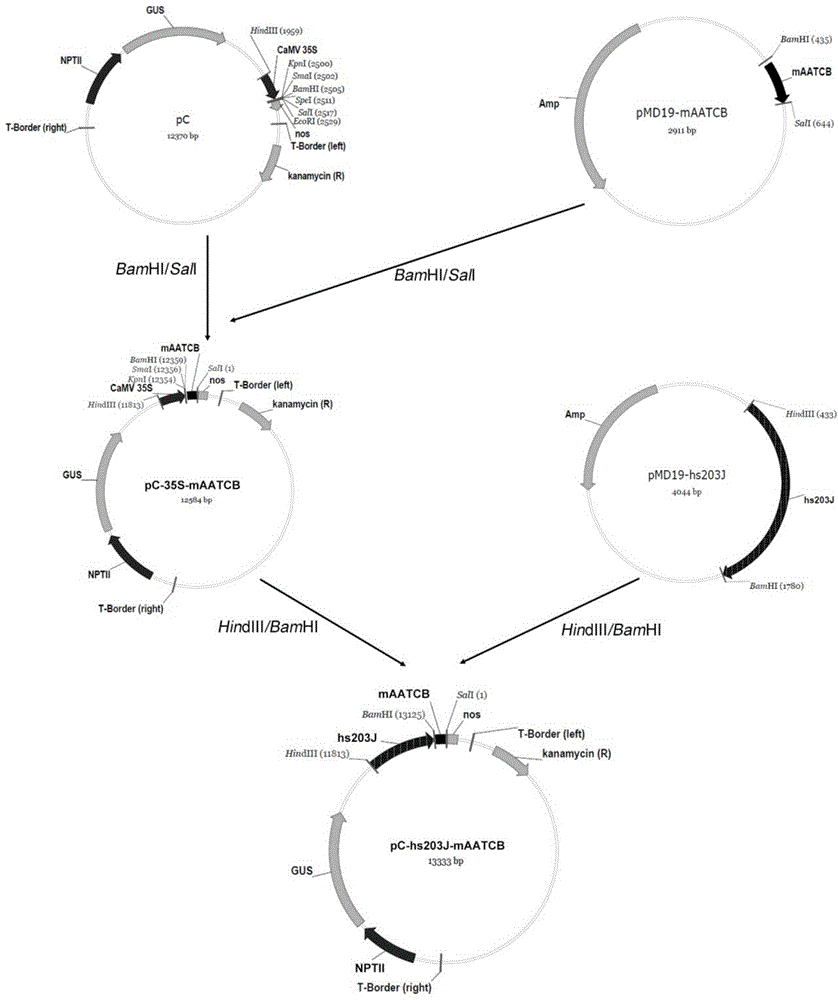Plant expression vector for antimicrobial peptide induced expression and application thereof
A plant expression vector and induced expression technology, applied in the field of plant expression vectors that induce the expression of antimicrobial peptides, can solve the problems that the resistance level of transgenic plants cannot be effectively improved, and it is difficult to achieve the bactericidal effect, so as to enhance the resistance of citrus canker, Enhanced resistance level effect
- Summary
- Abstract
- Description
- Claims
- Application Information
AI Technical Summary
Problems solved by technology
Method used
Image
Examples
Embodiment 1
[0046] Embodiment 1 vector construction
[0047] 1. Acquisition of a specific promoter
[0048] According to the tobacco pathogen-induced promoter PPP1 (GenBank accession number: AF469482.1), primers (SEQ ID No.1, SEQ ID No.2) were designed, and a fragment of about 1300 bp was obtained by PCR amplification from the tobacco genome. Sequencing analysis after cloning the amplified DNA fragment shows that it is a tobacco PPP1 specific promoter, see SEQ ID No.3.
[0049] According to the potato pathogen-induced promoter gst1 (GenBank accession number: J03679.1), primers (SEQ ID No.4, SEQ ID No.5) were designed, and a fragment of about 1600bp was amplified from the potato genome by PCR. Sequencing analysis after cloning the amplified DNA fragment shows that it is the gst1 specific promoter of potato, see SEQ ID No.6.
[0050] According to the tobacco pathogen-induced promoter hsr203J (GenBank accession number: X77136.1), primers (SEQ ID No.7, SEQ ID No.8) were designed, and a frag...
Embodiment 2
[0058] Example 2 Genetic transformation of citrus by the method mediated by Agrobacterium tumefaciens
[0059] The constructed plant expression vector plasmid was introduced into Agrobacterium EHA105 by electric shock method. Referring to the user manual of Bio-RAD MicroPulser, the vector described in Example 1 was introduced into Agrobacterium EHA105 by electroporation.
[0060] The above-mentioned expression vector was introduced into Jincheng through the method of Agrobacterium-mediated epicotyl, and the medium used is shown in Table 1. The specific method is as follows:
[0061] 1. Acquisition of epicotyls from Jincheng seedlings
[0062] Take fresh Jincheng and wash it, disinfect the surface with 70% alcohol, take out the seeds under aseptic conditions, peel off the seed coat, inoculate on MS solid medium, culture in dark at 28°C for 2 weeks, and then in 16h / d Cultured under photoperiod for 1 week. The epicotyls of germinated seedlings were taken and cut into stem seg...
Embodiment 3
[0074] Example 3 PCR detection of exogenous gene integration
[0075] Take 100 mg of transgenic citrus leaves, use Aidlab company kit (cat.No.DN15) to extract genomic DNA, and detect the integration of antimicrobial peptide gene mAATCB by PCR. The reaction volume was 25 μL, and the reaction conditions were: 94°C for 3 minutes; 30 cycles of 94°C for 30s, 58°C for 30s, and 72°C for 30s; 72°C for 10 minutes. For detection primers, see SEQ ID No.11 and SEQ ID No.12. The detection target fragment is about 100bp mAATCB antimicrobial peptide gene. Such as Figure 4 As shown, a specific fragment of the mAATCB antimicrobial peptide gene was detected in the genome of the transgenic plant, indicating that the antimicrobial peptide gene had been successfully integrated into the citrus genome.
PUM
 Login to View More
Login to View More Abstract
Description
Claims
Application Information
 Login to View More
Login to View More - R&D
- Intellectual Property
- Life Sciences
- Materials
- Tech Scout
- Unparalleled Data Quality
- Higher Quality Content
- 60% Fewer Hallucinations
Browse by: Latest US Patents, China's latest patents, Technical Efficacy Thesaurus, Application Domain, Technology Topic, Popular Technical Reports.
© 2025 PatSnap. All rights reserved.Legal|Privacy policy|Modern Slavery Act Transparency Statement|Sitemap|About US| Contact US: help@patsnap.com



